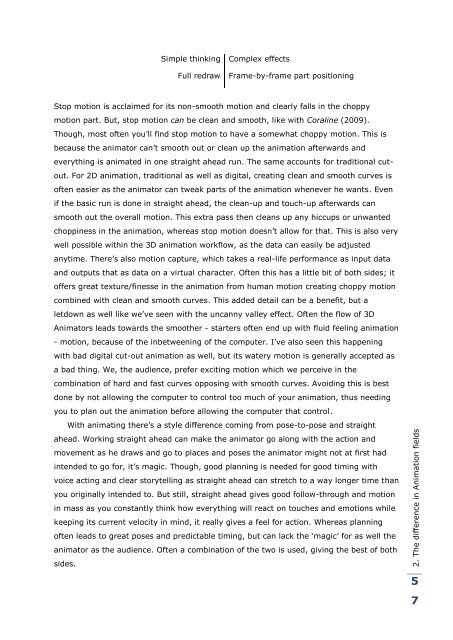Release. Pressure. Animate.
Release. Pressure. Animate.
Release. Pressure. Animate.
Create successful ePaper yourself
Turn your PDF publications into a flip-book with our unique Google optimized e-Paper software.
Simple thinking Complex effects<br />
Full redraw Frame-by-frame part positioning<br />
Stop motion is acclaimed for its non-smooth motion and clearly falls in the choppy<br />
motion part. But, stop motion can be clean and smooth, like with Coraline (2009).<br />
Though, most often you‟ll find stop motion to have a somewhat choppy motion. This is<br />
because the animator can‟t smooth out or clean up the animation afterwards and<br />
everything is animated in one straight ahead run. The same accounts for traditional cut-<br />
out. For 2D animation, traditional as well as digital, creating clean and smooth curves is<br />
often easier as the animator can tweak parts of the animation whenever he wants. Even<br />
if the basic run is done in straight ahead, the clean-up and touch-up afterwards can<br />
smooth out the overall motion. This extra pass then cleans up any hiccups or unwanted<br />
choppiness in the animation, whereas stop motion doesn‟t allow for that. This is also very<br />
well possible within the 3D animation workflow, as the data can easily be adjusted<br />
anytime. There‟s also motion capture, which takes a real-life performance as input data<br />
and outputs that as data on a virtual character. Often this has a little bit of both sides; it<br />
offers great texture/finesse in the animation from human motion creating choppy motion<br />
combined with clean and smooth curves. This added detail can be a benefit, but a<br />
letdown as well like we‟ve seen with the uncanny valley effect. Often the flow of 3D<br />
Animators leads towards the smoother - starters often end up with fluid feeling animation<br />
- motion, because of the inbetweening of the computer. I‟ve also seen this happening<br />
with bad digital cut-out animation as well, but its watery motion is generally accepted as<br />
a bad thing. We, the audience, prefer exciting motion which we perceive in the<br />
combination of hard and fast curves opposing with smooth curves. Avoiding this is best<br />
done by not allowing the computer to control too much of your animation, thus needing<br />
you to plan out the animation before allowing the computer that control.<br />
With animating there‟s a style difference coming from pose-to-pose and straight<br />
ahead. Working straight ahead can make the animator go along with the action and<br />
movement as he draws and go to places and poses the animator might not at first had<br />
intended to go for, it‟s magic. Though, good planning is needed for good timing with<br />
voice acting and clear storytelling as straight ahead can stretch to a way longer time than<br />
you originally intended to. But still, straight ahead gives good follow-through and motion<br />
in mass as you constantly think how everything will react on touches and emotions while<br />
keeping its current velocity in mind, it really gives a feel for action. Whereas planning<br />
often leads to great poses and predictable timing, but can lack the „magic‟ for as well the<br />
animator as the audience. Often a combination of the two is used, giving the best of both<br />
sides.<br />
2. The difference in Animation fields<br />
5<br />
7


